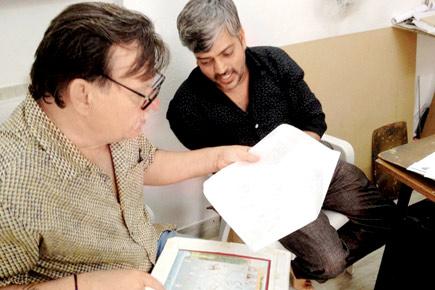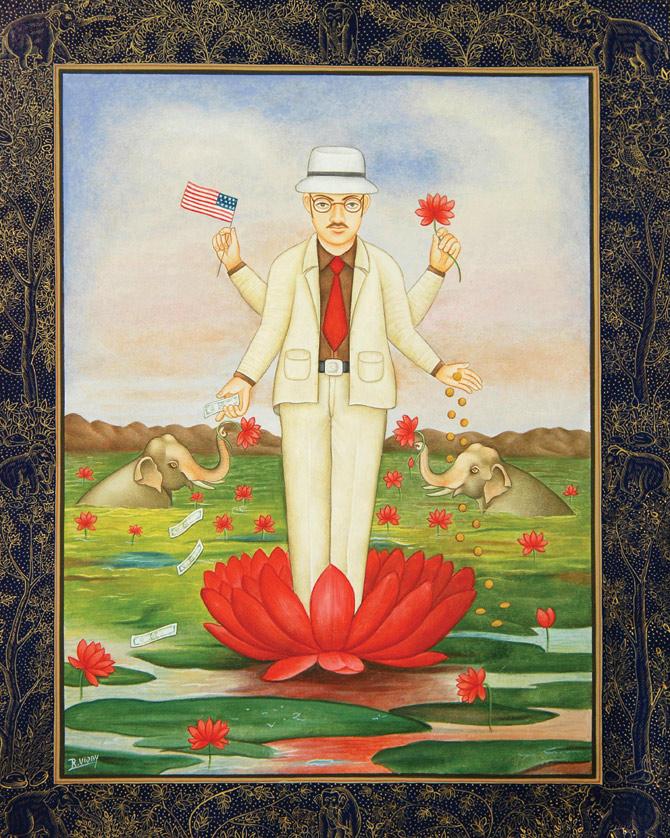A new book authored by Annapurna Garimella unravels the working partnership of American photographer Waswo X. Waswo and Rajasthani miniaturist R. Vijay

Collaborators Waswo X. Waswo and Rakesh Vijayvargia aka R. Vijay
ADVERTISEMENT
A set of 10 Indian miniatures, on which two artists have collaborated, was exhibited at a gallery in 2008. One artist was American photographer, who moved to India 16 years ago, Waswo X. Waswo, and the other was Rajasthani miniaturist R Vijay. Vijay signed the front of the miniatures, Waswo on the back. However, the gallery, and the art market, were apprehensive.
The value of the series, titled, The Secret Life of Waswo X. Waswo, could be downscaled if the 'right' artist did not find his place in the front. And that's how, and why, Waswo's sign shares space with Vijay's — on the face of the painting.

I See Myself as Laxmi — homage to Ravi Varma by Waswo X. Waswo and R. Vijay
"For artists like Vijay, it is very hard to get hold of a label bearing their names in a gallery," says art historian Annapurna Garimella. That Vijay did not get pushed behind the curtains is a rarity, she says. Garimella is the author of The Artful Life of R. Vijay, which will see a multi-city launch starting this week. After a private viewing in New Delhi at the home of Gallery Espace's founder Renu Modi, the Mumbai launch is set for April 7, at G5A, Mahalakshmi. If the titles of the book and the series resonate with each other, then it is no coincidence. The Secret Life of Waswo X. Waswo critiques the protagonist; while the book is Vijay's story of collaborations.

Collaborators Waswo X. Waswo and Rakesh Vijayvargia aka R. Vijay
Waswo has, in the last decade, collaborated with Vijay to create his life's story in pictures, collectively titled, A Studio in Rajasthan. It has discussed both the isolation and the kickback of being a foreigner in India.
R. Vijay is not a 'real' name. It is a condensation for convenience. "When I joined Waswo saab in 2006, he had some problems pronouncing my surname," says Rakesh Vijayvargiya, who hails from Rajsamand in Rajasthan. "His videshi mitr and kala premiyan (foreign friends and art lovers) couldn't get it right. And then I wondered, why not shorten it? It would be easier to sign that way too."
R. Vijay's surname rings a bell, and we are right in assuming that he is related to the late artist Ram Gopal Vijayvargiya, notable for his works, many of which borrow from Kalidasa's tales. The senior artist's works often pop up at auctions across the world, right from SaffronArt to Sotheby's, and we wonder why the grand-nephew R Vijay would part with such an
illustrious surname. "My lineage is not what makes me," he says, adding that he had the fortune of meeting his dadaji only once on a summer vacation when he was but a teenager.
Garimella, a specialist in the study of vernacular art histories, focuses on the miniatures made by Waswo and Vijay through their decade-long association. Rooted in the court painting traditions of Udaipur and Bundi, the miniatures feature anomalies — a fedora sporting, camera-trotting firang, who takes in Rajasthan. In I photograph the Palace of the Lake, the protagonist shoots the scene, and Garimella observes that the pristine white Lake Palace Hotel in the background is the product of tourism. Few refer to it by its original name — Jag Nivas.
Similarly, in I have learned to shit by squatting, the foreigner learns the mechanisms of the Indian loo, amidst resplendent peacocks and courtiers. The miniatures are cheeky as Waswo continues to parody himself. "My photographs have been criticised for following an Orientalist vein. The miniatures helped me tell a story of my life here. There are those who think that I was photographing the "natives", and living a life of privilege. But, when I started out in India, I was travelling by second-class sleeper and staying at backpacker guesthouses. I am certainly privileged now, but so are many other Indian artists," says Waswo, who works out of his studio in Varda, 30 minutes from Udaipur.
When the gallery-based artists work with vernacular ones, is it always exploitation? Garimella evokes the words 'commission' and 'collaboration' in the book, and reveals the processes followed by Waswo and Vijay. Through Vijay's hands, Waswo has been portrayed as the goddess Lakshmi as styled by Raja Ravi Varma, and there are depictions of homosexuality, too. Was Vijay concerned that he was disrupting a 400-year-old tradition? "My point in art is to tell the truth and miniatures have always depicted the social events of their times. They presented the truth, and these events are today's realities."
But more than technicalities, the strength of the association, in Waswo's words, lies in empathy. "Vijay gets it. We can't do without each other," he says.
 Subscribe today by clicking the link and stay updated with the latest news!" Click here!
Subscribe today by clicking the link and stay updated with the latest news!" Click here!







